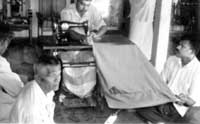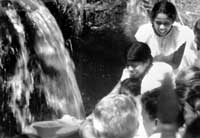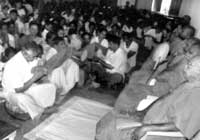
The robe of many meaningsBuddhist monks and Buddhists in the villages are trying to uphold the traditions and principles enunciated by the Buddha, though unfortunately in urban areas these traditions are disappearing with the fast changing economic situation. The offering of ‘Katina Cheevaraya’ after the period of 'Vas', before Il Poya is one such tradition and I had the opportunity to make my way to Hantane Raja Maha Vihara in the village of Uduwela where the monks depend purely on the contributions and alms of the villagers. Uduwela is at the beginning of the climb to Hantane, the range of hills considered the abode of 'Kohoma Deviyo'. The first Katina robe was gifted to Ven. Sasthrapathi Etulgama Upali Thera, a graduate of the University of Peradeniya residing at Hantane Raja Maha Vihare who had been observing 'Vas' for a period of three months. The Hantane Raja Maha Vihare had been built during the reign of King Kirthi Sri Rajasinghe by Galagoda Adikaram who gave it to the King who in turn gave lands for its maintenance and attached this vihare to the Asgiri Chapter.
This is perhaps the last temple that Sangharaja Weliwita Asarna Saranankara Thera visited for meditation though he was a monk from the Malwatta Maha Vihare. It is believed that he came here for meditation due to its serene atmosphere. All around the country, three months ago Upasampada Theras were invited by the people of the various villages, urban areas and the main towns to observe 'Vas’ with the coming of rains. This is the greatest gift to any Upasampada Thera and one which they look forward to during their priesthood. During the period of 'Vas' in the days gone by, three members of the Sangha visited Gautama Buddha, drenched in the rain. The Buddha felt sorry that it should have been so and decreed that one more robe could be had as a 'Katina' robe. It is the practice that a member of the Sangha could have only three robes which includes the underwear (Andanakade) and two other robes over it. The older generation of monks still wear the three robes as enunciated by Buddha. During the time of the Buddha, Jainism was at its height with nearly 76 sects practising the religion. They were in retreat during the rainy season in their own places, but the monks who were also perhaps in retreat used to go about in the rainy weather ministering to the needs of the people whom they were serving, though perhaps trampling insects and breaking young plants on their way. This was something that the Jains did not like. This may have also had some effect on the Buddhist monks. The Buddha thus laid down the principle that 'Vas' is a period when monks who have been vested with upasamapada should be in retreat during the three months of rain. The Buddha drawing a parallel from previous Buddhas, addressed Himself as to how best He could provide for His followers during the 'Vas’ season. The activities in a temple are at their best during the 'Vas' period when they have meditation programmes and sermons as laid down by Buddha. The Buddha decreed that this would also give them the opportunity to gain the highest merit. It was also shown that the laymen could also obtain merit by giving alms to the monks, who are at 'Vas’.
The beginning of the retreat is another formality, when three months prior to the offering of the Katina Cheevarya, the devotees of a temple invite the monks residing in the temple or if the temple has no resident monks, others to observe 'Vas'. On the appointed day all devotees gather in the "Bana Maduwa" (Preaching Hall ) and the elders of the village call upon the monks to observe 'Vas' with the offering of ‘Dahet’ (betel leaves). The monks and the elders come into an agreement with the devotees that they would observe 'Vas' in the particular temple and also not leave the temple without informing the devotees. The devotees agree to look after the needs of the monks, including medication. The monks on the Poya day of October, who believe that they could observe 'Vas' would go to their respective 'poya-ge's and recite " Patimokka" and each monk would invite fellow monks to point out any faults he may have committed. The ceremonies connected with the offering of the ' Katina Robe " are enacted as far as possible in keeping with the old rituals that has been followed since Buddhism had been introduced into the country. In the early hours of the morning on the day the ‘Katina Cheevaraya’ is to be offered, a white cloth is brought into the temple by devotees for the cutting and making of a robe. The robe is stitched at the pansala or temple in keeping with the tradition and this is then dyed and offered to the monks. It is then washed. The manner of handing over the 'Katina Cheevaraya' lies in the hands of the monks who had assembled on this day. After discussion, the offer in turn is made to the most deserving monk, it need not be a monk who had endured the 'Cheevara Masaya' or the month of retreat. Once the selection has been made by those monks who are present at the alms giving which goes with the offering of the 'Katina Cheevaraya' the process goes further when certain conditions are laid down by the elders on the monk who receives the robe. One of the conditions is that the robe should be in touching distance and that it should be touched every day when the monk wakes up in the morning. These are recited by two elder monks for the acceptance of the ‘Katina ' robe. At the end of the ceremonies an Anusasanawa (sermon) is followed for the benefit of the devotees. |
|| Front
Page | News | Editorial | Columns | Sports | Plus | Financial
Times | International | Mirror | TV
Times | Funday
Times || |
| |
Reproduction of articles permitted when used without any alterations to contents and the source. |
© Copyright
2007 | Wijeya
Newspapers Ltd.Colombo. Sri Lanka. All Rights Reserved. |


